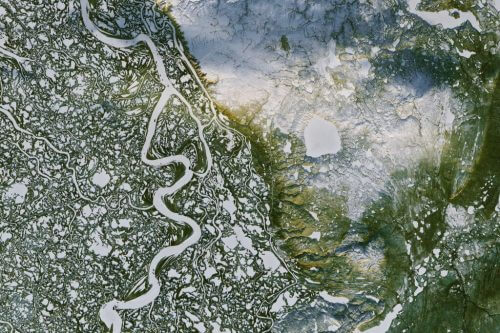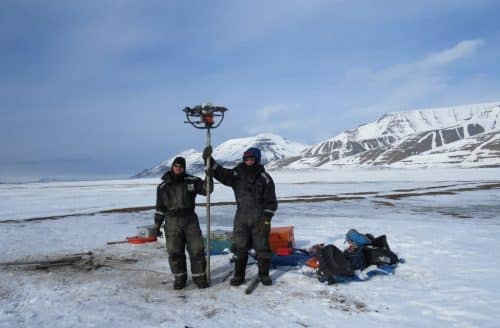The melting of the glaciers has long become the symbol of global warming. A groundbreaking study by Israeli researchers provides for the first time direct evidence that in the cold north of the earth not only the glaciers are melting, but also the soil

By Alina Arbitman, Angle, Science and Environment News Agency
A 12-year-old boy from the far north in Russia You're dead Per month August האחרון It probably wouldn't have grabbed headlines in newspapers around the world, if it weren't for the unique reason why it happened: the boy, a member of a shepherd tribe in the town of Selkhard in the Arctic Circle, died from the effects of the anthrax bacteria, which hadn't been seen in the area since 1941.
The boy was not the only one affected by the bacteria. Earlier, 2,300 reindeer died in the vicinity of the town, and 72 other shepherds were hospitalized after suffering from anthrax. According to reports in the local media, the boy's grandmother also died of anthrax in a herders' camp a week before.
Experts Believers Because the unusual outbreak of the bacterium is closely related to the effects of climate change. The warming in the area apparently caused the thawing of soils, which awakened dormant bacteria that had been frozen in the ground for hundreds and thousands of years. Now, the same bacteria find their way into the water of streams and lakes, and from there the path is short to the stomachs of humans and animals.
The experts' hypothesis is now being confirmed by a group of Israeli scientists, who in recent years have studied the thawing of the soils in the Arctic region and recently presented the first evidence that the thawing soil water finds its way into rivers and spring water.
The roads are starting to move
The Arctic Circle - the area around the North Pole where the sun does not set in the summer and does not rise in the winter - is mainly identified by the ice and snow that paint large parts of it white. But apart from the ice and snow, the soils in this area (which make up over a fifth of the world's soils) have been frozen for thousands and sometimes even hundreds of thousands of years, and for this reason they have been named permafrost or kifat-ad in Hebrew.
In recent years, far-reaching changes have been taking place in these lands. "Roads, airports and railroads that have been stable for many years are beginning to move, apparently because the permafrost soils on which they are built are losing water and sinking," explains Dotan Rotem, an ecologist in the Science Division of the Nature and Parks Authority and a doctoral student in the Department of Geography and Environment at Bar Ilan University, who is a partner in the research.

Beyond the local impact on buildings and infrastructure and the exposure of dormant bacteria, thawing may also have consequences on a global scale. The permafrost soils are locked in a much higher concentration of carbon than is in the atmosphere, which comes from remains of vegetation, a trace of the grass prairies that were in these areas before they froze. When these soils thaw, biological activity begins, which eventually releases a lot of carbon dioxide into the air, as well as other greenhouse gases, which in turn add to the increase of the greenhouse effect and global warming.
Until recently, all the evidence about the thawing of the land was indirect, until a team of researchers from Israel entered the picture. Prof. Yishai Weinstein from the Department of Geography and Environment at Bar Ilan University, together with Rotem, decided to look for direct evidence of the thawing of the permafrost in an unexpected place: in streams and springs. Rotem explains: "Above the permafrost layer there is an active soil layer that thaws every year in the summer season and freezes again in the fall, so it is natural to think that it is the one that will supply the water to the streams. But we decided to check if there is a characteristic that distinguishes between the permafrost and the active soil layer. If we find the characteristic of the permafrost in the water of springs and streams in the vicinity, then it can be said that the permafrost is the source of the water, that is, that this ground does thaw.'
The answer is buried in the frozen ground
This is similar to hydrological research where they look for chemical and physical characteristics of the water in order to trace its course. "For example, if the water on Mount Hermon has a special characteristic that is also found in the streams at its foot, then we can say that the water comes from it, but we may find in the stream a characteristic of the water in the restaurant on the Golan Heights, and then we will come to the conclusion that the course of the water is different," explains Weinstein. "Similarly, by examining the composition of the groundwater it is even possible to determine whether the source of the rain that fell in the distant past in Africa is from water that evaporated from the Atlantic or Indian Ocean."
Weinstein is the head of the laboratory for radioactive isotopes in Bar Ilan. Radioactive isotopes are instances of different chemical elements, whose atoms are characterized by instability and their tendency to disintegrate and become atoms of other elements while releasing radiation. By tracking radioactive isotopes, it is possible to trace the origin and rates of movement of various substances in the natural system. "For example, we use radioactive isotopes to trace the discharge of groundwater into the sea," explains Weinstein. "One bright day, it occurred to us to investigate the permafrost using the same methods."
The material chosen for the task is radium - a radioactive metallic element common in the earth's soils, which is also found in permafrost. Radium has several isotopes, the most stable of which decays within thousands of years. In the past, when the permafrost ground froze, the radium that was in the ground was trapped in the ice, and thus its long-lived isotope continued to accumulate there undisturbed. On the other hand, in the water of the active layer of the soil, the one that thaws and freezes every year, there is a washing of the water every few months, which does not allow the long-lived isotope to accumulate in it, and therefore its lower concentrations are found there.

Now that they were able to find the isotopic characteristic that differentiates the two soil layers, the researchers hoped to find the characteristic of the permafrost in the water of the local rivers, which would make it possible to determine that the source of the water is in the permafrost. But in research as in research, the road there was not so easy.
Hard ground like concrete
In 2014, Weinstein arrived for the first time with a research team in Svalbard, an archipelago in the Arctic Sea located between Norway and the North Pole, to test his research hypothesis. He recounts his first encounter with the permafrost: "We are Israelis and do not know frozen ground. Up until that moment we only had an idea, and all our knowledge of the permafrost was from the literature. We started drilling into the ground, and at a depth of about 60 cm we reached a very hard material, which reacted like concrete. I was very surprised, so a local colleague told me: 'We have reached the ceiling of the permafrost.'"
Since the first visit to Svalbard, the researchers have returned to the island several times, for several weeks each time, and their research methods have been refined from visit to visit. Weinstein recalls: "In the beginning we were naive and used methods that required a wait of almost a day from the moment of drilling in the ground, and after the ground thawed we got mud. This was of course a big nonsense. Since we have perfected it, we use a microwave and a centrifuge and within a few minutes manage to separate the water from the soil. We pass the water through a manganese-coated fiber, which adsorbs the radium, and on which we perform the measurements.'
The field work bore fruit, and the isotopic signature of the permafrost also appeared in water streams in Svalbard, as the researchers hypothesized. But they were not satisfied with determining that the water of the streams came from the frozen ground, and now they are trying to determine the age of its freezing as well. Weinstein explains: "Radioactive materials allow us not only to determine the source, but also to perform dating, because they decay at a predetermined rate." Now Rotem is working on defining the freezing age of the soils in collaboration with Dr. Yehudit Harelvan and Dr. Yosef Yehiali from the Geological Institute, and they already have preliminary results. "We found that the soils are frozen between a thousand and 3,000 years," Rotem explains. "Since it is known from other studies in geology that they were formed a few thousand years ago, then it is not possible that they are frozen much longer than that."
The study, presented inconference the annual To science and environment, will soon be published in Permafrost and periglacial processes, the most prestigious scientific magazine in the field of permafrost research, and is supported by the National Science Foundation of Israel and done in collaboration with UNIS University in Svalbard. "UNIS University helped us with snowmobiles, drills, special clothes for the terrain and more," says Weinstein. "If it weren't for them, we wouldn't have been able to carry out the research."
Weinstein and Roth's research helps in understanding the global trends of the effects of climate change. To this Weinstein adds: "Israel funds research near the North Pole. In my eyes, this indicates that we are still normal and able to raise our eyes above our local troubles."
See more on the subject on the science website:

One response
As it is written there was a forest regardless of man and therefore there will be a forest regardless of man (who earns his living from global warming)